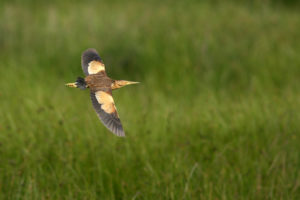Night-time flight calls
To separate NFCs of Little Bittern from those of the other small herons, frequency is the best clue. Their usual NFCs are so high-pitched that confusion with other heron species (at least in Europe) seems unlikely (mean frequency 2.1 kHz, n = 133). I determine mean frequency by measuring the lowest and highest possible part of the call and taking the mean of the two values. In poor recordings you will only see the power-carrying frequency alone and measuring is easy. Ironically, it becomes more difficult when the recording is good and the call shows particularly well in the sonagram. In this case I try to exclude harmonics when measuring. Usually, however, the mean values of either broader or narrower measurements do not differ considerably.
But looking at frequency alone is certainly not enough. The shape of the call can vary and there are two basic types of NFCs. The first type, which I associate with short-distance contact, is the one that makes them sound like grumpy gnomes mumbling to themselves. The calls are quieter and usually have a much denser distribution of frequency bands than the others. These may sometimes be associated with a flock of Little Bitterns calling to each other to maintain contact.
The second type, which I associate with long-distance contact, is both commoner and louder. It sounds more enthusiastic and has less densely distributed frequency bands, which only appear if the recording is good enough.
Both types of Little Bittern NFCs sound more or less like ker and both can have an additional croakiness, which makes them look more blurred in sonagrams.
Little Bittern Ixobrychus minutus, Potistika, Argalasti, Greece, 05:01, 3 September 2017 (Lukas Pelikan). Short-distance contact calls of a grumpy gnome mumbling to himself, calls at 0:01, 0:25, two at 0:27 and 0:39. Background: crickets and a party starting at 0:36
In general the NFCs (of both types) have an arched shape but with emphasis on the descending part, making the whole call sound slightly descending. Sometimes, with better sound quality, the call looks like a more complex construction, still with an arch visible but with additional parts above, which look like an incomplete bridge over the arch. I believe these are not harmonics related to the fundamental frequency but additional elements produced simultaneously. With increasing croakiness things become more and more blurred (ie, several elements merge together).
Little Bittern Ixobrychus minutus, Potistika, Argalasti, Greece, 00:48, 29 August 2017 (Lukas Pelikan). One single ker of a bird by night.
Little Bittern Ixobrychus minutus. Eight variations of ker calls, all except 3) representing long-distance contact. 1) Potsdam, Germany, 02:28, 28 August 2016 (Lukas Pelikan), 2) Hohne, Harz National Park, Germany, 01:25, 22 September 2017 (Lukas Pelikan), 3) Potistika, Argalasti, Greece, 05:01, 3 September 2017 (Lukas Pelikan), 4) Potistika, Argalasti, Greece, 03:02, 4 September 2017 (Lukas Pelikan), 5) and 6) Potistika, Argalasti, Greece, 22:23 and 22:59, 6 September 2017 (Lukas Pelikan), 7) Potistika, Argalasti, Greece, 00:48, 29 August 2017 (Lukas Pelikan), 8) Potsdam, Germany, 01:29, 9 August 2016 (Steve Klasan)

In more southerly places like Israel or Azerbaijan, Little Bittern flocks of around 40–50 or sometimes several 100 can be seen migrating by day (Shirihai 1996). At Besh Barmag, a well-studied site for nocturnal migration in Azerbaijan, Jonas Buddemeier recorded this flock of c 40 along with some Purple Herons flying by in the evening. You can hear the short- and long-distance contact calls and all sorts of croakiness. What a charming bunch of gnomes!
Little Bittern Ixobrychus minutus, Besh Barmag, Siazan, Azerbaijan, 19:00, 4 October 2017 (Jonas Buddemeier). Flock flying by on the windy Caspian Sea shore with Purple Heron Ardea purpurea flight calls from 0:40 onwards.


